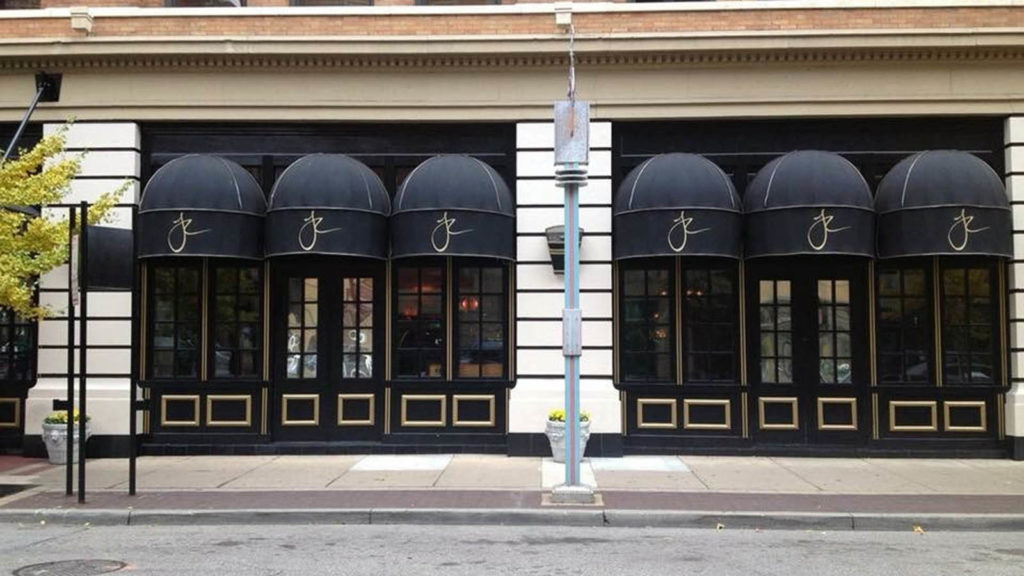By Bruce N. Wright, FAIA

Fabric awnings and canopies can provide energy savings, thermal and visual comfort, weather protection from sun, rain, snow, sleet, hail and wind—all while offering brand identification and architectural aesthetics. Modern architectural fabrics meet many critical design needs, such as durability, ease of maintenance, fire resistance, high strength-to-weight ratio and corrosion resistance. Many fabrics have a 15-year warranty, and some options have up to 20- and 30-year warranties. Fabrics also feature special top coatings with flame-resistant (FR) ratings and resistance to pollution and grime.
The biggest advantages for fabric over metal are its much lighter weight and overall lower carbon footprint in the manufacture and installation processes. When selecting a fabric, your ultimate choice may depend upon its availability and price point. The most important quality in choosing a fabric is its fire resistance. NFPA 701 is the most common test for textiles and films; ASTM E-84, 108 and 136 are common tests for fabrics used in structures. Always check with your fabricator to determine the best fabric options for the project.
Primary Awning and Canopy Fabrics
Solution-dyed acrylic
This acrylic comes in a wide range of UV-resistant colors, depending on weave; it is highly breathable.
Solution-dyed modacrylic
While it is similar to acrylic, this fabric has increased flame resistance and heat sensitivity. The fibers are translucent depending of the color.
Solution-dyed polyester
The yarn is spun with the color embedded in the solution (just like solution dyed acrylic), providing enhanced UV resistant colors along with increased strength and dimensional stability. It is also highly breathable.
Vinyl-laminated polyester
Some laminated PE fibers are designed for backlighting and are often recommended for areas with sustained high humidity.
Vinyl-coated polyester
This fabric is primarily used for illuminated awnings; its degree of translucence depends on the color.
Acrylic-coated polyester
The translucence of this fabric depends on the color; it is resistant to UV, mildew and water.
Common Fabric Structure Fabrics
ePTFE
PTFE yarns are woven into PTFE-extruded fabric that penetrates the base scrim on both faces. This permits the fabric to be repeatedly flexed and folded with minimal damage. This fabric has high light transmission rates up to 40 percent and life expectancy of more than 30 years.
ETFE foil
This fabric has self-cleaning capability; plus it is UV resistant and has a life span of more than 20 years. It has a thermal performance average of 2.6-U value in a two-layer system, it is 20 times lighter than glass and is 100 percent recyclable.
PTFE-coated glass fiber
Known for high tensile strength, this fabric is UV resistant, can be cleaned with water and is available with varying translucencies up to 15 percent. Its FR rating varies, but fabric melts rather than burns at high temperatures.
Mesh
This is a broad term for any porous fabric; it can be made from almost any fiber either woven or knitted (which can use HDPE, PP or acrylic yarns). Nylon can be used in industrial applications due to its strength and chemical resistance. PP and HDPE are stain-resistant but cannot be dyed for colors and are less expensive than PE or nylon.
Polyester
PE is the most frequently used base material because of its strength, durability, cost and stretch. PVC-laminated or coated PE is the least expensive fabric for long-term applications. It offers multiple options for top coating, including PVF or PVDF to withstand environmental degradation.
Vinyl-coated PE
The most common fabric for awnings, canopies, walkways, small air-supported structures and light-framed structures, this fabric can be made with high light transmissions or can be 100 percent opaque.
Vinyl-laminated PE
This fabric is most commonly used for awnings, tents and low-tension frame structures. Lamination prevents moisture wicking into the base scrim; adhesives used can stop fungal growth and freezing of the exterior coatings.
PTFE-coated woven PTFE
This fabric offers high resistance to the environment and the ability to flex or fold repeatedly, which lends it best to retractable covers or shades where long durability requirements hold. It features the highest light transmission rates of up to 55 percent and a low VOC option. It is more expensive than PVC-coated materials.
Shadecloth
Originally made for agricultural use to protect crops, it is most often knitted using monofilament PE. It has now been adapted to tension structures primarily designed to shade. Many colors are available; shade factor can vary from 20 to 90 percent, with UV filtering factors from 30 to 70 percent.
Bruce N. Wright, FAIA, is an architect and consultant to architects. He is a senior instructor at Dunwoody College of Technology and frequent contributor to IFAI publications.
 TEXTILES.ORG
TEXTILES.ORG


